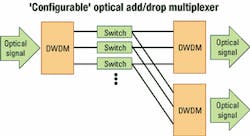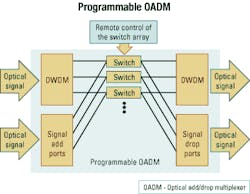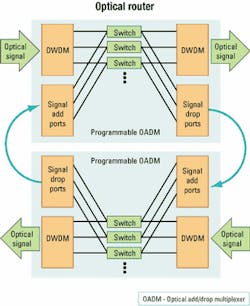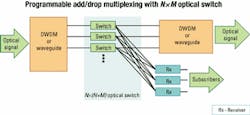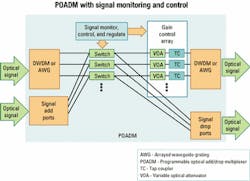Programmable OADM a missing link to all-optical networks
These programmable devices provide flexibility while removing costly OEO conversions.
JASON LIAO, Global Opticom Inc.
The all-optical network (AON) revolution has begun in many parts of the world, and its ideology is the heart and soul of many new networking companies. To keep up with such massive bandwidth increases, network equipment companies are rolling out systems that can process signals optically and minimize costly optical-electrical-optical (OEO) conversion.
Because of this trend, the demand for optical components such as DWDM equipment, optical add/drop multiplexers (OADMs), optical switches, and splitters has skyrocketed. In addition to these discrete optical components, telecommunications equipment companies are making headway in delivering novel integrated modules, enabling the accelerated deployment of AON.
MANs are at the forefront of the AON wave. Companies are building large-scale, optical routing equipment to handle the high-speed, large-capacity optical traffic. MANs comprise various ring networks interconnected with one another; thus, the ability to perform optical add and drop functions is one of the key enabling features in an AON.However, network carriers currently employ high-speed, high-capacity electronic routers in switching the network traffic (see Figure 1). Such techniques are costly, cumbersome, and outdated quickly. As soon as the carriers need more bandwidth, multiple sets of expensive and higher-speed electronic routing equipment have to be added. In addition, switching among different network protocols is either difficult or impossible to do since most routers are protocol-dependent. With the explosion of voice, video, and data traffic, a protocol-independent, high-capacity, and all-optical solution is needed in today's networking environment.
The development of OADMs, which "switch" optical traffic based on the specific wavelength requirement partly solves the problem of protocol dependency. However, traditional OADMs, though widely employed in the AON, lack the flexibility of making dynamic changes. They are configured with a fixed channel count, and as need increases, they cannot be upgraded easily.Therefore, remote configuration of the OADM is possible, which leads to the birth of the programmable OADM (see Figure 3). A programmable OADM (POADM) will incorporate 2x2 optical switches to enable signal drop and add functions. The programming can be based on network capacity needs, subscriber requirements, and/or optimization schemes. Companies are developing complex control and feedback systems in response to the needs of various optical-networking environments.
By pairing up two identical POADMs, the system becomes an optical router, exchanging information between two independent optical networks (see Figure 4). As the signal channel of the ring network is switched from one POADM to the drop port, the corresponding add port for the same channel of the paired POADM picks up the signal and guides the signal into its own network ring. At the same time, the original signal in the paired POADM is also rerouted into the other ring network.
As a result, signal exchange be tween two independent networks is possible. Such information ex change is more cost-effective than the OEO method. POADM-based routers are protocol-independent. Therefore, the same setup can be used to switch voice, video, and data. Carriers no longer have to worry about different standards among service providers. As technology improves in sending information at higher bit rates, the same setup can still be used.
The performance of the POADM is limited by its multiplexer/demultiplexer components and the optical switches, since they are the system's only building blocks. As an example, the maximum insertion losses for certain 16-channel 100-GHz and 200-GHz POADMs from input to drop ports are 8.5 and 7.5 dB, respectively, using a proprietary manufacturing process with advanced thin-film optical filters. The optical performance penalty of the POADM is the added optical-switch insertion loss. Currently, a 2x2 mechanical switch that can be paired with the POADMs just described has insertion loss of less than 0.8 dB. As WDM component and optical-switch technology advances, POADM optical performance will improve.The switching speed of the POADM is influenced by the combination of electrical and mechanical components. The actual mechanical movement of the light-routing device inside the optical switch, the command processing time for switch actuation, and the electronic communication time between devices are contributing factors in the overall switching time of the POADM. To improve the switching speed of the POADM, the design in the electronic portion will need to be optimized.
Many options can be explored to reach this goal. For example, the command processing time might be reduced by streamlining the programming codes. Also, the communication speed between different electronic components might be increased by implementing a high-speed communications protocol.By taking advantage of array-type switches, POADMs can also incorporate an Nx(N+M) optical switch instead of a series of 2x2 optical switches (see Figure 5). N is the number of demultiplexed ports and M is the number of drop ports. With such a design, the physical location of the drop ports is also configurable because signals can be dropped to any of the output ports. This capability is useful at the receiving end of the network, where limited receivers are available.
A network carrier can route a signal to different receivers depending on its requirement. Such a design not only gives providers more flexibility, but also cost savings because of the reduction in the total number of the receivers needed. Signals being downloaded part-time can now be shared with other channels using the same receiver.Balancing the signal strength among all channels is an important task in achieving the best network condition. With POADMs, the signal not only can be added and dropped, but also active monitoring and controlling of the signal are possible. A tap coupler can be added to monitor the strength of each channel. Then a series of voltage-controlled optical attenuators can be added at the proximal ends of the tap couplers to regulate the signal strength (see Figure 6). In this way, the signal strength can be balanced whether it is coming from the demultiplexer or the add port. This configuration is useful when two ring networks have different signal strengths.
The OADM has evolved a long way since the invention of WDM. With the integration of optical and electronic devices, optical add and drop functions can be controlled remotely and the need for OEO conversion can be eliminated. The next-generation POADM aims to be a "smart" module in which more optical functions in addition to dynamic add/drop can be realized within a compact package. With these innovative and customer-tailored modules, the realization of AONs worldwide will happen faster than people think.
Jason Liao is the operation engineering manager at Global Opticom (Sunnyvale, CA).


